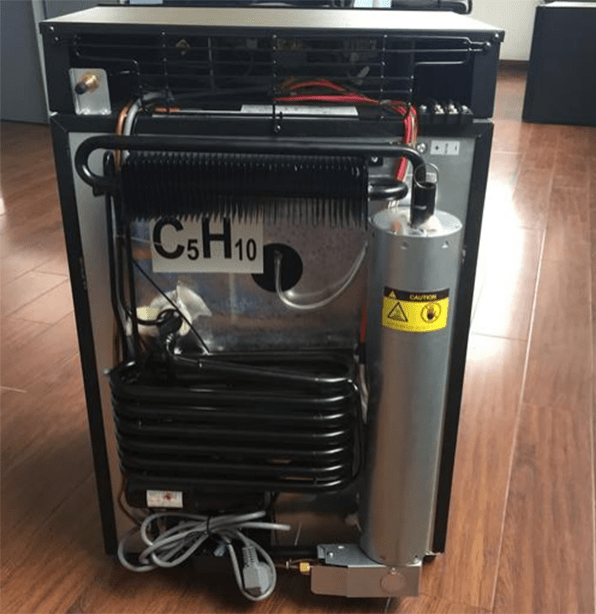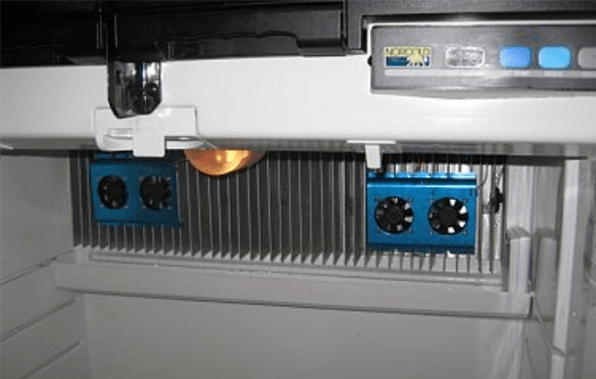Video: A Comprehensive Guide to RV Refrigerator Fans: Basics, Types, Functions & Installation

Figure 1: RV absorption refrigerator.
Recreational vehicles (RVs) are synonymous with adventure and freedom, allowing enthusiasts to explore the open road
without sacrificing the comforts of home. Among the crucial components of an RV is the refrigerator.
However, RV absorption refrigerators, unlike their residential counterparts, face unique challenges such as uneven
cooling and limited airflow. This is where an RV refrigerator fan
comes into play.
In this article, we delve into the role of an RV refrigerator fan, exploring its types, functions, and the essential
tips for maintaining optimal performance, particularly in hot weather conditions.
1. What is an RV Refrigerator Fan?
Before delving into the intricacies of RV refrigerator fans, let's understand the refrigerator itself. Unlike
traditional residential refrigerators, RV refrigerators commonly operate on absorption refrigeration technology.
These refrigerators are designed to run on multiple power sources, including propane, electricity, and battery
power.
The unique challenges faced by RV refrigerators, such as uneven cooling, led to the development of specialized fans
to enhance their efficiency.

Figure 2: The back of an absorption refrigerator.
2. RV Refrigerator Fan Types
2.1 RV Fridge Fin Fan (Interior Fridge Fan)
This type of fan is installed inside the refrigerator compartment. Its primary function is to circulate air within
the confined space, ensuring that the cold air reaches every corner. The improved air circulation minimizes hot
spots and cold spots, leading to a more uniform temperature throughout the refrigerator.
The RV Fridge Fin Fan is a compact, battery-operated or hard-wired (12V DC) device that enhances the refrigerator's
overall performance.

Figure 3: freezer compartment of an absorption refrigerator.
2.2 RV Refrigerator Vent Fan (Exterior Ventilation Fan)
Unlike the interior fridge fan, the RV refrigerator vent fan is installed on the exterior part of the refrigerator, specifically in the ventilation area. Its purpose is to improve airflow around the cooling fins and enhance heat dissipation. This type of fan is crucial for maintaining optimal refrigerator performance, especially in high-temperature conditions.

Figure 4: RV refrigerator ventilation fan set.
3. Function of RV Refrigerator Fan
RV refrigerators, operating on propane, face unique challenges that differ from traditional compressor-based refrigerators or residential refrigerators
(Most of them already have fans built in). The RV refrigerator fan plays a crucial role in enhancing the efficiency
and performance of absorption refrigerators commonly found in recreational vehicles.
Here are the key functions of an RV refrigerator fan:
3.1 Temperature Regulation
One of the primary functions of an RV refrigerator fan is to regulate the internal temperature of the refrigerator. Absorption refrigerators operating on propane, unlike compressor-based counterparts, can experience uneven cooling. The fan helps circulate air within the confined space, preventing temperature variations and ensuring a consistent and stable temperature throughout the refrigerator.
3.2 Preventing Hot Spots and Cold Spots
Uneven distribution of cold air can lead to hot spots and cold spots within the refrigerator. The RV interior fridge fan addresses this issue by promoting air circulation. By strategically placing the fan near the cooling fins, it helps distribute cold air more evenly, eliminating temperature disparities within the refrigerator.
3.3 Enhancing Cooling Efficiency
The RV refrigerator operates on the principle of absorption, where a combination of heat, ammonia, and hydrogen is used to create a cooling effect. In warmer climates or during hot weather, the absorption process can be less efficient. The interior fridge fan assists in maximizing cooling efficiency by ensuring that the cold air reaches all parts of the refrigerator inside, even in challenging conditions.

Figure 5: RV fridge fin fans.
3.4 Preventing Condensation
Condensation can be a concern inside an RV refrigerator, particularly in humid conditions. The interior fridge fan helps reduce the likelihood of condensation by maintaining a more consistent temperature. By circulating air, it minimizes the chances of moisture accumulation, preventing potential issues like mold and mildew.
3.5 Improving Airflow in the Ventilation System
The RV exterior vent fan plays a crucial role in improving airflow in the ventilation system of the refrigerator. As the absorption process generates heat, the exterior fan expels hot air from the ventilation area, preventing overheating. This helps the refrigerator maintain its cooling capacity even in high-temperature environments.
3.6 Energy Efficiency
The proper functioning of the RV refrigerator fan contributes to overall energy efficiency. By ensuring that the
cooling process is optimized and that the refrigerator doesn't have to work harder than necessary, the fan helps
conserve energy and extend the life of the refrigerator components.
In summary, the RV refrigerator fan, whether installed inside or outside the refrigerator, is a critical component
for maintaining a stable and efficient cooling environment in a mobile setting. It addresses challenges unique to
absorption refrigerators, ensuring reliable performance, especially in varying climates and weather conditions.
4. Where Should the Fan of an RV Refrigerator Be Installed?
4.1 Interior Fridge Fan Placement
The RV Fridge Fin Fan should be strategically placed inside the refrigerator compartment. Position it near the cooling fins for optimal airflow. The goal is to circulate the cold air evenly, preventing hot spots and cold spots.
4.2 Exterior Vent Fan Placement
Install the RV Refrigerator Vent Fan on the exterior part of the refrigerator, specifically in the ventilation area. This placement helps in expelling hot air generated by the absorption process, maintaining a cooler environment for the refrigerator components.

Figure 6: The installation diagram of the exterior vent fans for an RV refrigerator from mortonsonthemove.com.
5. Tips for Keeping Your RV Refrigerator Working Reliably in Hot Weather
5.1 Choose the Right Location
Park your RV in shaded areas whenever possible to minimize exposure to direct sunlight. This helps reduce the workload on the refrigerator, especially during hot weather.
5.2 Level Your RV
Ensure that your RV is parked on a level surface. Proper leveling is crucial for the optimal functioning of the absorption refrigerator, preventing cooling issues caused by uneven distribution of ammonia.
5.3 Use Reflective Covers
Invest in reflective covers for your RV's windows and refrigerator vents. These covers help deflect sunlight and reduce the impact of external heat on the refrigerator, aiding in temperature regulation.
5.4 Regular Maintenance
Keep the interior fridge fan and exterior vent fan clean from dust and debris. Regular maintenance ensures uninterrupted airflow and efficient heat dissipation.

Figure 7: RV absorption refrigerator.
6. Conclusion
In the realm of RV living, where mobility meets comfort, the RV refrigerator fan plays a pivotal role in ensuring
the reliable performance of absorption refrigerators. Investing in an RV refrigerator fan is a practical and
cost-effective way to overcome the cooling challenges unique to recreational vehicles.
Understanding the types, functions, and proper maintenance of these fans is essential for RV enthusiasts looking to
make the most of their mobile adventures, particularly in challenging weather conditions. By embracing these
insights, RV owners can embark on their journeys with confidence, knowing that their refrigerator is equipped to
handle the demands of the road.



